

Boulangerie. Chef! How to Make Parathas (pan-fried Indian flatbread) Parathas (pan-fried Indian flatbread) are for when you want to spoil yourself!
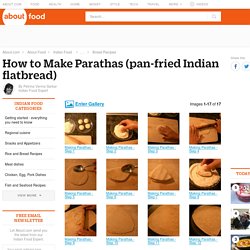
Crispy and flaky, they go well with most Indian dishes be it a gravied curry or a dry stir-fry. Learn how to make them with this step-by-step photo tutorial. How to Make Chapatis (Indian flatbread) Joe Pastry… Joe… …is a guy who believes that if a man feels like whipping up a nice almond cocoa genoise or a few madeleines, well…he should be able to.
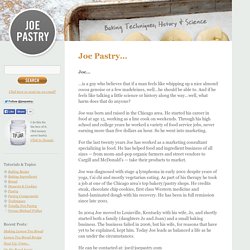
And if he feels like talking a little science or history along the way…well, what harm does that do anyone? Joe was born and raised in the Chicago area. He started his career in food at age 15, working as a line cook on weekends. Through his high school and college years he worked a variety of food service jobs, never earning more than five dollars an hour. For the last twenty years Joe has worked as a marketing consultant specializing in food. Bread. Mark Your Calendars: Baking Workshop on December 20 at 12PM...

Live in NYC! Learn to bake 6 different holiday cookies at our Italian Baking Workshop: Sweets for The Holidays. I have such a good time baking, and I love sharing my creations with friends and family. This brand new Italian baking workshop is my way of inviting into my kitchen for a fun-filled afternoon of holiday baking, during which you'll not only learn to bake six very different, and very delectable, sweets... you'll get to taste them all, and bring some home for your loved ones to enjoy. We'll bake buttery morsels from Sicily, stuffed with dried figs and nuts plumped in Marsala wine; anise-kissed white wine taralli, shaped like tiny pretzels, so good dunked in sweet wine; addictively crisp hazelnut biscotti from Piedmont; jam-filled pecan cookies that melt in the mouth; Calabria's famous fig biscotti, laced with cinnamon and orange zest; and delicate cornmeal cookies from the Veneto.
Follow us on. Stages of Yeast Bread Baking. A Baker's 14 Bread Making Steps — BREAD Magazine. Making a great loaf of bread is a process that takes time — from the few hours to make a quick yeasted bread to up to 48 or more when working on slow fermented sourdough breads — so it’s usually a good idea to plan ahead a little bit.

How to Make Bread. N early all breads contain 3 primary ingredients—flour, liquid, and yeast—and are made using the same simple steps.

With these basics, you can produce an incredible variety of flavors and textures by adjusting the types and amounts of ingredients used (for instance store-bought yeast versus natural airborne yeasts) and the way the steps are employed. We'll address ingredients later in this primer, but below we've outlined the steps of the bread-making process and the variations on each. 1. Measuring Ingredients The first step in bread-making is, of course, measuring the ingredients.
If you prefer to measure by volume, try to be as accurate as possible. 2. Science of Bread: Bread Science 101. From Chinese baozi to Armenian lavash, bread comes in thousands of forms.
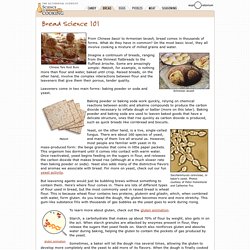
What do they have in common? On the most basic level, they all involve cooking a mixture of milled grains and water. Imagine a continuum of breads, ranging from the thinnest flatbreads to the fluffiest brioche. Some are amazingly simple: Matzoh, for example, is nothing more than flour and water, baked until crisp. Raised breads, on the other hand, involve the complex interactions between flour and the leaveners that give them their porous, tender quality. Leaveners come in two main forms: baking powder or soda and yeast.
Baking powder or baking soda work quickly, relying on chemical reactions between acidic and alkaline compounds to produce the carbon dioxide necessary to inflate dough or batter (more on this later). Gluten Development (with Windowpane Photos) Retarding Dough For Flavor Enhancement and Process Control. The information below is taken from an EXCELLENT discussion in the Bread Baker's Guild of America baking list.

It is hard to overstate how much I have learned from this group, and strongly encourage any serious baker, amateur or professional, to join and support the guild. Much of the information is from Abe Faber, the owner of the Clear Flour Bread outside Boston. Abe is one of the keystones of the Bread Baker's Guild of America, and one of a handful of people to whom I happily defer. The first part of this discussion is fairly technical, but at the end I'll bring it around to home practices for serious home bakers. However, I think the earlier information is very important to understanding how retarding dough works.
There are three essentially different kinds of possible process involving the use of refrigeration, which are all too often lumped together under the broad title, "retardation. " Why do we use more yeast if we want to retard the dough? Lesson Three: Time & Temperature. The difference between mediocre bread and excellent bread usually has less to do with the ingredients being used than the process involved in creating it.
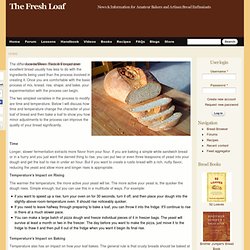
Once you are comfortable with the basic process of mix, knead, rise, shape, and bake, your experimentation with the process can begin. The two simplest variables in the process to modify are time and temperature. Problems and Solutions - Pre-ferments and Sourdough Starters. Copyright © 2000 Sarah Phillips Sarah Phillips, Inc.
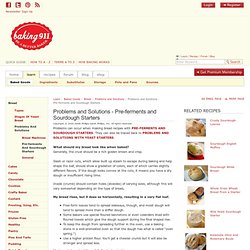
All rights reserved.Problems can occur when making bread recipes with PRE-FERMENTS AND SOURDOUGH STARTERS. They can also be traced back to PROBLEMS AND SOLUTIONS WITH YEAST STARTERS. What should my bread look like when baked? Generally, the crust should be a rich golden brown and crisp. Bread and dough troubleshooting guide and table.